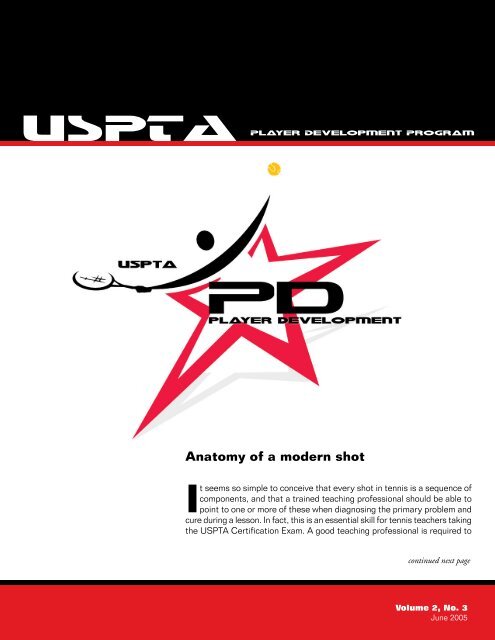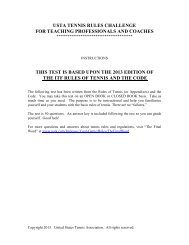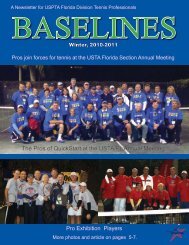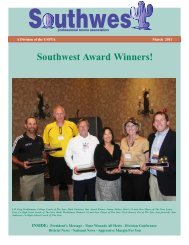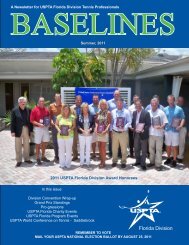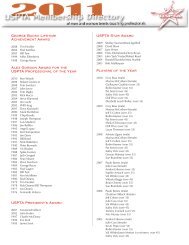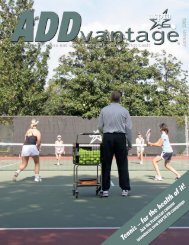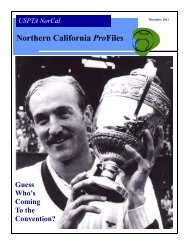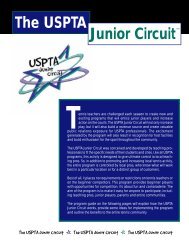Volume 2, No. 3 - United States Professional Tennis Association
Volume 2, No. 3 - United States Professional Tennis Association
Volume 2, No. 3 - United States Professional Tennis Association
You also want an ePaper? Increase the reach of your titles
YUMPU automatically turns print PDFs into web optimized ePapers that Google loves.
USPTA Player<br />
Development Program<br />
Anatomy of a modern shot<br />
It seems so simple to conceive that every shot in tennis is a sequence of<br />
components, and that a trained teaching professional should be able to<br />
point to one or more of these when diagnosing the primary problem and<br />
cure during a lesson. In fact, this is an essential skill for tennis teachers taking<br />
the USPTA Certification Exam. A good teaching professional is required to<br />
continued next page<br />
<strong>Volume</strong> 2, <strong>No</strong>. 3<br />
June 2005
see each shot component, from ready position to recovery, in<br />
exceptional detail and use this information, along with a keen<br />
understanding of how each component affects the other, to form<br />
and communicate a diagnosis and cure.<br />
Of course, it’s not so simple. Try to write the shot components in<br />
sequence and it doesn’t take long to realize that determining the<br />
components is much easier than explaining in strict order when<br />
and how each occurs. This is because a shot is executed so fluidly<br />
that many of the components don’t occur at only one point in the<br />
sequence, but often overlap.<br />
Footwork, for example, clearly is a major component of every shot.<br />
We can declare it begins in earnest after reaction time, since you<br />
begin moving toward a shot during movement time as shown in<br />
Exhibit I. But, obviously, it continues to play a critical role during<br />
all subsequent shot components as we circle back to responding<br />
to the next shot in the rally. Since the feet never stop moving<br />
during a point, there is no clear beginning and ending point of the<br />
footwork component. And, while we do not show the kinetic chain<br />
as a separate component in Exhibit I, it likewise is a critical factor<br />
in many shot components. It is illustrated as a chain linking the<br />
components it most affects.<br />
Thus, there will always be room for pros to critique the order in<br />
which this information is presented and, perhaps, the information<br />
itself. This is the privilege that USPTA never has and never will<br />
attempt to usurp from its members, all of whom have significant<br />
contributions to make to the teaching of the game. Our intention<br />
is simply to present the materials in an understandable order,<br />
explaining the shot components as information units that members<br />
may accept as they are or rearrange within the reasonable<br />
boundaries of their own expertise.<br />
With this in mind, if we insist on simplifying the sequence of each<br />
shot, we would probably accept Exhibit I as an explanation of the<br />
primary components and their interactions with one another.<br />
The three phases of a shot:<br />
As seen in Exhibit I, the 11 primary shot components can be<br />
categorized into three distinct phases:<br />
1. Preparation phase<br />
2. Hitting phase<br />
3. Recovery phase<br />
This insert will deal only with the preparation phase including:<br />
1. Foreperiod, 2. Reaction time and 3. Movement time. We<br />
will undertake one or more of the other phases sequentially<br />
in upcoming magazines. Again, remember that each of<br />
the components with their subcomponents and respective<br />
explanations are excellent stand-alone topics that can be used<br />
in your lesson plans immediately.<br />
Exhibit II is a more detailed look at the shot components that<br />
occur during the preparation phase:<br />
2
Exhibit II: The preparation phase of a shot<br />
1.<br />
Foreperiod<br />
A.<br />
Positive<br />
Physical<br />
Response<br />
B.<br />
Time to<br />
Strike-zone<br />
B.<br />
Relaxation<br />
Experience<br />
Reaction Time + Movement Time = Response Time<br />
A.<br />
Final<br />
Grip<br />
C.<br />
Planning<br />
3.<br />
Movement<br />
Time<br />
D.<br />
Rituals<br />
C.<br />
Muscle<br />
Impulse<br />
E.<br />
Visualization<br />
Preparation Phase<br />
B.<br />
Brain<br />
Impulse<br />
F.<br />
Anticipation<br />
A.<br />
Intro. of<br />
Stimulus<br />
G.<br />
Ready<br />
Position<br />
2.<br />
Reaction<br />
Time<br />
H.<br />
Grip<br />
1. Foreperiod:<br />
The foreperiod is most often thought of as the 25 seconds the<br />
rules allow between points. However, it also occurs in a faster<br />
and more automated way during the short time a player has<br />
between sequential shots in a rally, perhaps with some of the<br />
skills omitted.<br />
The eight skills comprising the foreperiod may seem to be too much<br />
to ask a player to think about. It would be if each of them always<br />
happened as individual steps in a deliberate process. The key is that<br />
most of what happens in the foreperiod happens unconsciously and<br />
automatically, as a product of experience. As players learn about<br />
themselves through competition – such as their bodies’ physical<br />
reactions to stress and their tendencies when they’re ahead in a<br />
match and when they’re behind – they will develop the skills that<br />
keep them focused, relaxed and competitive.<br />
focus between points. In regard to positive physical response,<br />
Loehr says that as a point ends, players can facilitate the<br />
flow of positive emotion or reduce the chance that negative<br />
emotion will interfere with play, with their physical actions<br />
and mental responses. For example, make a quick, decisive<br />
move with your body the instant the point ends. Pump your<br />
fist if you won the point or clap your hand and racquet if<br />
your opponent hit a great shot. Or, make a quick, decisive<br />
move away from a mistake. Project a confident image. Let<br />
both arms hang freely at your sides, hold your shoulders<br />
back, head up and eyes forward to project an energetic,<br />
competitive image.<br />
On the other hand, as coaches and teachers, we have to be<br />
able to identify those skills that need improvement and require<br />
conscious thought and training. The importance of these skills<br />
can’t be underestimated, since the majority of time in a match<br />
elapses not during play but between points, games and sets.<br />
The foreperiod is a danger zone where emotions, distractions<br />
and other factors can interfere with players’ mental and physical<br />
preparation.<br />
A. Positive physical response<br />
In The Mental Game, Winning at Pressure <strong>Tennis</strong>, Jim Loehr,<br />
Ed.D., provides his “16-second cure” to help players maintain<br />
3<br />
Acknowledging an opponent’s good shot is not only good sportsmanship,<br />
but will also help you move on to the next point in a positive manner.
A player doesn’t need to say anything, but Loehr offers<br />
guidelines if you do: If you lost the point due to a mistake,<br />
say to yourself “<strong>No</strong> problem,” or “Let it go.” If you lost the<br />
point due to your opponent’s great shot, say “Nice shot.” This<br />
takes the pressure off you. If you won the point, say “Yes” or<br />
“Come on.”<br />
However, pumping fists and saying “Yes” should only be<br />
done for oneself and not in the face of an opponent or for the<br />
purpose of gamesmanship.<br />
The goal is to keep a consistent level of positive energy during<br />
a match since big fluctuations can impede performance. The<br />
level of positive physical response that is helpful to a player will<br />
be determined individually, depending on a player’s personality<br />
and ability to focus.<br />
Players should continue a positive posture while walking to the<br />
area behind the baseline. You can shake out your hands, stretch,<br />
spin the racquet in your hand, bounce the ball on the strings,<br />
or towel off at the back of the court. It is also important to<br />
breathe deeply and slowly. To maintain excellent concentration,<br />
your eyes should be on a fixed object such as your strings or<br />
on the ground. It is also important to keep your feet moving. In<br />
high-stress conditions, blood flow will pool in the feet and legs<br />
and slow you down if you stand still. The more stressful the<br />
previous point or the more important the next point, the more<br />
time you should take in the stage. Think only relaxing, calming<br />
thoughts such as “Settle down,” “It’s OK” or “Relax.”<br />
Most people respond well to winning a point, but will need to<br />
practice a positive physical response after the loss of a point,<br />
game or set. With experience and a coach’s help, players will<br />
find what works for them, and it may have to be practiced like<br />
any shot or tactic.<br />
Additional examples of positive physical responses after losing<br />
a point are:<br />
· Shadow the missed shot and visualize hitting it<br />
successfully.<br />
· Do not show any emotion.<br />
Reacting the same way to points won or lost can help stabilize<br />
emotions over the course of a match.<br />
Players maintain concentration by focusing on strings or other fixed objects.<br />
Player relaxes his grip by holding racquet in nondominant hand and<br />
high on racquet throat.<br />
Moving the racquet to the nondominant hand is a great way to<br />
relax the dominant hand. This is a good response to winning or<br />
losing a point. Just as common, and likely just as effective, is<br />
loosening the grip of the dominant hand and letting the throat<br />
of the racquet settle into the hand.<br />
B. Relaxation<br />
A relaxation response allows the body to recover from the<br />
physical and emotional stress of the previous point and return<br />
to the optimal arousal level, according to The Mental Game.<br />
4<br />
There are 25 seconds between the end of one point and the<br />
beginning of the next in which to perform all of the functions<br />
related to the foreperiod. Players will establish an optimum<br />
rhythm (be it slower or faster) for moving to the baseline to<br />
begin the next point. As long as the rhythm is working and the<br />
player is performing at a high standard, there is no reason to<br />
break this rhythm by speeding up or purposely taking all 25<br />
seconds allotted.<br />
On the issue of deep breathing, Angus Mugford, Ph.D., mental<br />
conditioning coach at Bollettieri <strong>Tennis</strong> Academy, suggests<br />
the following breathing technique: “Let your stomach expand<br />
as you inhale. As you exhale, say the number five, on the<br />
next breath exhale with four, then three and so on. This fivecount<br />
technique will help break down the lactic acid in your<br />
body, provide oxygen to your brain and focus on the now!”<br />
This technique is helpful in maintaining concentration and<br />
overcoming nervousness or choking.
C. Planning<br />
The Mental Game says that as soon as you move toward the<br />
baseline to serve or receive, you should make sure you know<br />
the score and your plan for the next point. If you’re serving,<br />
pause a foot or two from the baseline. Say the score, looking<br />
directly at your opponent. “Project the strongest, most<br />
confident and aggressive image possible… The same is true<br />
on the service return. The receiver should project as powerful<br />
an image as possible, looking directly at the opponent as if to<br />
say, ‘I am confident I will win this point.’”<br />
Many players bounce the ball as part of their serve ritual.<br />
Mentally, Loehr suggests that, at this point, you give no<br />
thought to technique, grips, or strategy since that was done<br />
during the planning stage. Most players benefit from a quick<br />
mental rehearsal of the serve or return that includes a clear<br />
image of where they want the ball to go. <strong>No</strong> self-talk is<br />
recommended during this stage.<br />
Once you’ve established your rituals, it is important to continue<br />
using them.<br />
Projecting confidence is key.<br />
Make a conscious decision about what to do on the next<br />
point, Loehr writes. In order to plan and establish tactics and<br />
strategies for the upcoming point, consider the game score,<br />
set score, your strengths and your opponent’s weaknesses.<br />
Consciously plot out what you intend to do, either with<br />
thoughts (e.g., “Go to net”) or images (visualization).<br />
D. Rituals<br />
As soon as you step up to the baseline in the serve or return<br />
position, you should begin a ritual or sequence of automatic<br />
physical movements that deepen concentration, balance<br />
intensity with appropriate muscle relaxation, and produce an<br />
instinctive, automatic form of play, Loehr writes. For the server,<br />
two things have proven important – bouncing the ball a minimum<br />
of two to three times prior to the serve and pausing just after<br />
the last bounce. This pause seems to keep players from rushing<br />
their service motion under pressure. On the return, the ritual<br />
usually involves bouncing on their feet or swaying back and<br />
forth. Some players spin the racket; others blow on their hands.<br />
But your eyes should be fixed on the ball on the other side. The<br />
return ritual ends with a split-step, moving forward just prior to<br />
the server’s contact with the ball.<br />
5<br />
E. Visualization<br />
It’s been said that if you can see it, you can do it. A chapter<br />
in World-Class <strong>Tennis</strong> Technique described this research<br />
regarding visualization: “Players consistently report that<br />
visualizing the serve or serve return before the start of<br />
the point facilitates execution. Using images to mentally<br />
rehearse complex biomechanical movements typically does<br />
not lead to the ‘paralysis by analysis’ syndrome. The recreation<br />
of experience through images stimulates an entirely<br />
different area of the brain from logical, analytical thought.<br />
Stimulation of the nondominant hemisphere of the brain,<br />
which is what happens in visualization, facilitates instinctive<br />
and automatic play.<br />
“Using visualization to correct mistakes during play can have<br />
a very positive effect on mechanical precision. Simply ‘feeling’<br />
the correct stroke or mentally and physically rehearsing the<br />
specific correction before the next point builds confidence and<br />
positive response expectancy.”<br />
While we’re discussing using visualization on court, we should<br />
also note that it should also be practiced off the court, as<br />
described in Maximum <strong>Tennis</strong> by Nick Saviano: “The ability<br />
to visualize yourself executing in competition is essential to
Ready position. Sampras is in ready position for the<br />
return of serve as the toss leaves Korda’s hand.<br />
Partial anticipation. Korda’s toss has reached its<br />
peak and Sampras is already moving toward the<br />
center of the court. We can surmise that, using<br />
partial anticipation, Sampras has eliminated the<br />
likelihood of a wide serve to his forehand and is<br />
looking for a backhand. His experience versus Korda<br />
and the toss location were Sampras’ clues.<br />
Split step. Sampras is pushing off the ground to<br />
initiate a split step.<br />
achieving your goals. When top Olympic coaches and elite<br />
athletes from a wide variety of sports were surveyed as to<br />
the most important factors in their psychological training<br />
programs, they named visualization, or imagery, as number<br />
one in importance.<br />
“Try to visualize yourself performing on the court exactly the<br />
way you would like. If you have trouble with a particular shot,<br />
learn to visualize yourself hitting that shot particularly well.<br />
If you have trouble serving out a match, visualize yourself<br />
serving out the game with confidence. In preparation for<br />
a match, many professionals will actually get away by<br />
themselves shortly before competing and visualize certain<br />
aspects of the match or specific shots. Others practice their<br />
visualization at night.<br />
“It sounds corny, but for most players it really works. If you are<br />
to play in the club championships and you simply don’t believe<br />
you can win it, take some time each day and visualize yourself<br />
playing in the final match. Picture yourself being totally under<br />
control, executing great shots and winning the last point. The<br />
more vivid your visualization, the better. Try it, and you will be<br />
surprised just what an effective tool it is.”<br />
F. Anticipation<br />
“Anticipation often is broken down into two classifications: total<br />
and partial anticipation,” according to the USA <strong>Tennis</strong> High<br />
Performance Coaching Program manual. “Total anticipation<br />
is predicting what the opponent will do in a given situation;<br />
partial anticipation is predicting what the opponent will not do<br />
in a given situation. Partial anticipation is what most commonly<br />
happens on a tennis court, because a player rarely is able to<br />
predetermine exactly what shot his or her opponent is going<br />
to hit and where the ball will go.<br />
6<br />
“Partial anticipation is important. It assists the player in<br />
responding more quickly to a ball because it reduces the<br />
number of possible responses from his or her opponent. It also<br />
helps the player decide which of the possible options he or she<br />
may use to execute a particular shot.”<br />
The manual goes on: “Anticipation is needed during match play<br />
because of the great demand for player movement and the<br />
short times available for adjustment and movement to a ball<br />
returned by an opponent. The ball takes roughly 0.4 seconds to<br />
get from one end of the court to the other, depending upon the<br />
type of shot it is and how hard it was hit. Players need between<br />
0.3 to 0.5 seconds to move from their current positions to<br />
positions in which they can hit the ball. Therefore, the returner<br />
must have the ability to anticipate the shot in order to allow<br />
this sequence to occur and to minimize the chance of errors.<br />
“Additional research regarding anticipation shows that players<br />
lose the ball for approximately one to two meters immediately<br />
after impact and can then focus closely on the ball when it is<br />
traveling over the net. Players also have trouble seeing the<br />
ball when the ball comes within one to two meters in front of<br />
them, as the human eye is unable to follow the ball during<br />
its entire trajectory. This research sheds important light on<br />
the importance of being able to anticipate and predict ball<br />
trajectory and flight patterns based on cues.”<br />
The four major factors that provide information needed for<br />
anticipation are described in Maximum <strong>Tennis</strong> like this:<br />
1. “Type and quality of your opponent’s shot. By being<br />
aware of the type of shot (its direction, speed, spin,<br />
height, trajectory, and depth) and the quality of the shot,<br />
you can anticipate where and how the ball is going to
Brain impulse. Sampras is reading the impact of<br />
the serve.<br />
Muscle impulse. Sampras has read the serve as<br />
going to his left. He has landed his split step<br />
with the right leg, enabling him to push off more<br />
efficiently for a backhand return. The time between<br />
this photo and the previous one represents reaction<br />
time. <strong>No</strong>w movement time is beginning.<br />
Continuing with the movement you can see by<br />
referencing the background of this photo how much<br />
Pete has moved to his left in a short period of time.<br />
bounce. Obviously, this type of anticipation occurs after<br />
your opponent has hit the ball.<br />
2. Patterns, tendencies, strengths, and weaknesses. This<br />
involves knowing the patterns and tendencies of your<br />
opponent, as well as his strengths and weaknesses.<br />
Based on that information, your ability to anticipate what<br />
your opponent may or may not do improves tremendously.<br />
Scouting your opponents, practicing together, or having<br />
played them in previous matches helps you develop this<br />
type of anticipation.<br />
3. Opponent’s court position. This involves knowing the<br />
ramifications of your opponent’s court position on the<br />
type of shot she can hit. For example, if your opponent<br />
has moved back well behind the baseline, you can logically<br />
conclude that she will not be hitting a low line drive from<br />
far behind the baseline. She most likely will hit the ball<br />
with a high net clearance to put the ball deep.<br />
4. Cues from your opponent’s stroke. This is about your ability<br />
to pick up cues from your opponent’s technique. <strong>No</strong>tice<br />
what grip he is using, his balance, the swing path of his<br />
racket, his footwork (or lack thereof), his body stance, his<br />
ball toss, and the like. All these aspects of your opponent’s<br />
stroke production will give you clues as to what type of<br />
shot he is preparing to hit.”<br />
G. Ready Position:<br />
When we use the term ready position, often the first thing that<br />
comes to mind is the return of serve. In this instance the ready<br />
position implies that a player is in place, balanced, with knees<br />
flexed, feet shoulder width apart, moving foot to foot and ready<br />
to make a split step and move to return the oncoming ball.<br />
7<br />
Obviously the return of serve is not the only ready position<br />
that applies in tennis. There is a ready position for the return,<br />
the serve and, in a more complex way, every shot in a rally.<br />
What’s important to note is the commonalities about ready<br />
position, whether a player is returning serve or is rallying from<br />
the baseline and looking for a chance to get to net.<br />
· The ready position should be a position of balance that<br />
best allows a player to be prepared to move. It will be<br />
slightly different for each player, depending on factors<br />
such as body type.<br />
· Although many think of it this way, a deep knee bend and<br />
low body position aren’t necessarily ready position. Good<br />
players may start that way, but will extend their knees a<br />
bit and bounce or come slightly off the ground. So, as<br />
they prepare to move, they are slightly higher than when<br />
waiting to see what would happen.<br />
· As players prepare for another shot during a rally, ready<br />
position is more likely to be a brief hesitation than a pause<br />
in a complete ready position. A player will hesitate in a<br />
spot that allows the best opportunity to explode in the<br />
direction of the oncoming ball.<br />
· Finding ready position, or an instant of hesitation, will<br />
take place based on anticipation. For instance, it may be<br />
judged on court geometry based on the previous ball hit<br />
and the expected return. The player may even fade toward<br />
the backhand side, instead of the middle of the angle, in<br />
order to get a better chance at a forehand.<br />
· Ready position should allow the player to face the ball,<br />
not the net, with the only exception being a ball hit deep<br />
to the center of the court.
Response Time<br />
Reaction<br />
Time<br />
Movement<br />
+ Time =<br />
Response<br />
Time<br />
H. Grip:<br />
Generally, a player waits with a certain grip and shifts to the<br />
precise grip for the next shot while bouncing into a split step<br />
and moving toward strike-zone set up. These actions in an<br />
advanced player are so fast and spontaneous that they almost<br />
seem to take place simultaneously.<br />
2. Reaction Time<br />
Similar to the outline in Exhibit II (Page 3), the USA <strong>Tennis</strong> High<br />
Performance Coaching Program manual defines reaction time this<br />
way:<br />
“Reaction time is the interval of time between the onset of a<br />
signal or cue, often called the stimulus (2a), and the initiation<br />
of a response. It is the amount of time it takes the brain to<br />
recognize what to do (brain impulse, 2b) combined with the time<br />
it takes for the muscles to start to move for the shot (muscle<br />
impulse, 2c).”<br />
A longer foreperiod for the returner, which is allowed by a server<br />
who bounces the ball many times and/or has a higher toss, impacts<br />
reaction time differently than a shorter foreperiod allowed by a<br />
server who steps up to the line and serves without bouncing the<br />
ball or who serves a low toss such as Roscoe Tanner or Kevin<br />
Curren.<br />
Reaction time can be trained, however most research suggests<br />
that a faster reaction time of 10 percent would be the most one<br />
could hope to improve. It is suggested that a minimum of 100<br />
practice trials would be necessary to expect any significant<br />
result.<br />
3. Movement Time:<br />
Movement time is the time between the muscle impulse and<br />
completion of a movement, or the time it takes to move to address<br />
an oncoming ball.<br />
Movement time includes:<br />
a. Change to the final grip<br />
b. Time to the strike zone<br />
· For this example, the reaction time was the period of<br />
time from the visual cue or recognition of a drop shot and<br />
the initiation of forward movement toward the ball.<br />
· The movement time was the period of time between the<br />
initiation of forward movement and the completion of the<br />
return shot for a winner.<br />
· The response time was both the reaction time and the<br />
movement time required to complete this exchange.”<br />
Credits and thanks<br />
We owe thanks and credit to several USPTA members who<br />
generously contributed their research and knowledge to this<br />
issue:<br />
· USPTA’s Player Development Advisory Council: Nick<br />
Bollettieri, Jack Groppel, Ph.D., Jim Loehr, Ed.D., Rick<br />
Macci, Paul Roetert, Ph.D. and Eliot Teltscher, David T.<br />
Porter, Ed.D., Tim Heckler, USPTA CEO<br />
· World-Class <strong>Tennis</strong> Technique, Paul Roetert, Ph.D., and<br />
Jack Groppel, Ph.D., editors<br />
· USA <strong>Tennis</strong> High Performance Coaching Program<br />
manual<br />
· The Mental Game, Winning at Pressure <strong>Tennis</strong>, Jim Loehr,<br />
Ed.D.<br />
· David T. Porter, USPTA Education Committee Chairman<br />
and professor at Brigham Young University – Hawaii<br />
· Maximum <strong>Tennis</strong>, Nick Saviano<br />
· Mike Kernodle, Ph.D., associate professor at Appalachian<br />
State University and member of the USPTA National<br />
Education Committee<br />
· Angus Mugford, Ph.D., mental conditioning coach at<br />
Bollettieri <strong>Tennis</strong> Academy<br />
· John Yandell and Advanced <strong>Tennis</strong> Research Program’s<br />
high-speed video of world-class players<br />
Here’s an example of how this concept applies to tennis from<br />
the High Performance Coaching Program manual: “A player is<br />
standing on the baseline after hitting a backhand that travels to the<br />
opponent, landing on the opponent’s service line. As the opponent<br />
moves forward to retrieve the shot, the player notices visually that<br />
the racket face of his opponent is opening up, having the technical<br />
qualities required for a drop shot. The player immediately begins<br />
running forward to retrieve the drop shot, reaches the ball just<br />
before its second bounce, and hits a winner down the line deep<br />
into the opponent’s backcourt.<br />
8


